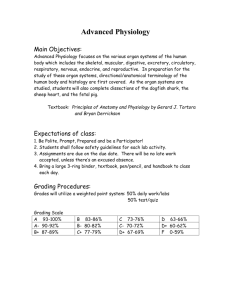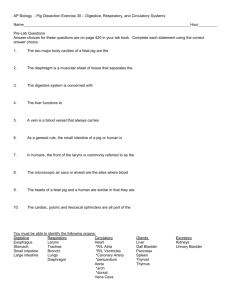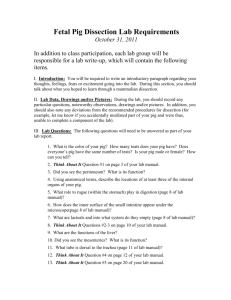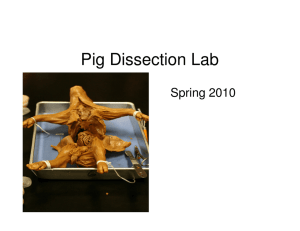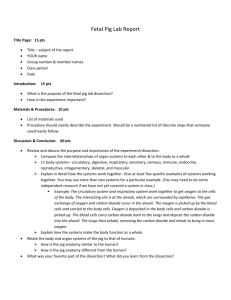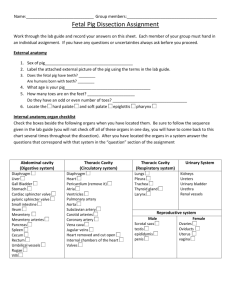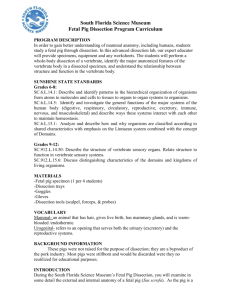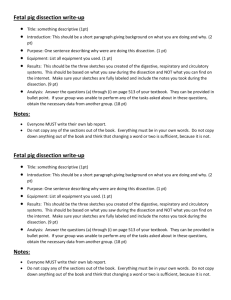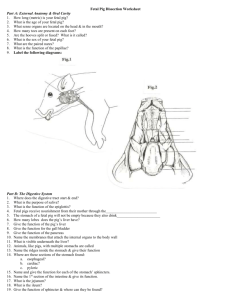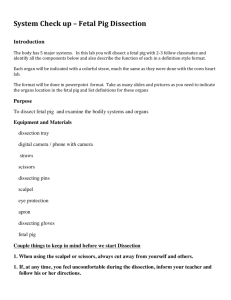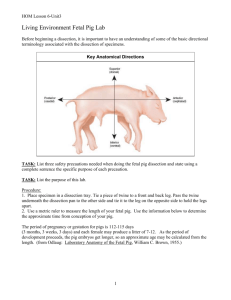Criteria - KCI-SBI3U
advertisement
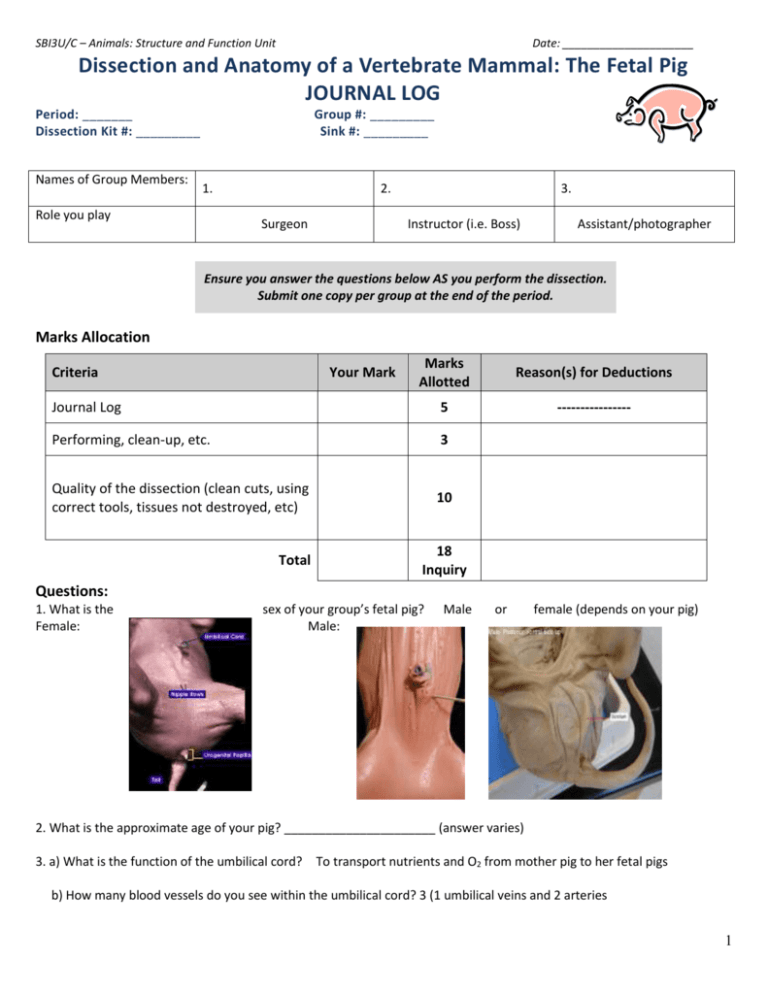
SBI3U/C – Animals: Structure and Function Unit Date: _____________________ Dissection and Anatomy of a Vertebrate Mammal: The Fetal Pig JOURNAL LOG Period: _______ Dissection Kit #: _________ Names of Group Members: Group #: _________ Sink #: _________ 1. Role you play 2. Surgeon 3. Instructor (i.e. Boss) Assistant/photographer Ensure you answer the questions below AS you perform the dissection. Submit one copy per group at the end of the period. Marks Allocation Marks Allotted Reason(s) for Deductions Journal Log 5 ---------------- Performing, clean-up, etc. 3 Quality of the dissection (clean cuts, using correct tools, tissues not destroyed, etc) 10 Criteria Your Mark Total 18 Inquiry Questions: 1. What is the Female: sex of your group’s fetal pig? Male: Male or female (depends on your pig) 2. What is the approximate age of your pig? ______________________ (answer varies) 3. a) What is the function of the umbilical cord? To transport nutrients and O2 from mother pig to her fetal pigs b) How many blood vessels do you see within the umbilical cord? 3 (1 umbilical veins and 2 arteries 1 4. a) Do you notice any hair? Yes or No (answer varies) b) Does your fetal pig have eyelashes? Yes or No (answer varies) c) Does your fetal pig have a tongue? Yes or No 5. Which portion of the small intestine does the gallbladder connect to? duodenum 6. Why are liver, gall bladder and pancreas collectively called accessory organs? Because they are peripheral organs; they are not really part of the digestive tract but they are involved in the chemical digestion of food 7. What is the function of the peritoneum? Where is it found? Layer of connective tissue that holds abdominal organs in place. Found in the abdominal cavity 8. What is the advantage of having such a film (mesentery)? Where is it found? To allow the long small intestine to coil and fit in the small compartment of the abdominal cavity; found surrounding the small intestine 9. As an accessory organ in digestion, what vital substances does the pancreas provide? Pancreatic Amylase and lipase as well as hormones such as insulin, glucagon 10. What is the function of the spleen? Recycle old red blood cells and store white blood cells and platelets 11. What do you notice when you observe the inner lining of the stomach under the dissecting microscope/magnifying glass? Rugae –foldings of the stomach; also observed the cardiac and pyloric sphincter 12. a) How is the small intestine different from the large intestine? Lighter color, smaller in diameter and longer b) What is the length of the unraveled small intestine? ______________ answer varies 13. Do you notice any difference in the size of the two lungs? Explain. Yes, the left lung lobes are smaller to accommodate the heart 14. Why do the lungs feel spongy? Due to the air sacs (i.e. alveoli) that fill it 15. What function do the cartilage rings of the trachea serve? To support the airway keeping it open all the time 16. Where is the esophagus in relation to the trachea? It is dorsal (behind)to the trachea 2 17. What do you notice between the sizes of the walls of the atria and the ventricles? Ventricle walls are thicker wall than atria 18. Why does the left ventricle contain more muscle than the right ventricle? Because the left ventricle provides a stronger propulsive force to pump blood throughout the body 19. Indicate in the following table whether the blood should be O2-rich (i.e. oxygenated) or O2- poor (i.e. deoxygenated) at the locations specified by #(4m) 7. poor 8. rich 9. poor 10. rich 11. Septum 12. rich 13. rich 14. poor 15. poor 16. poor 18a. What chambers of the heart receive blood from the body, ventricles or atria? atria b. What chambers of the heart pump blood out of the heart, ventricles or atria? ventricles c. Which blood vessel brings oxygen poor blood to the heart from the rest of the body? Superior and inferior vena cavae d. Which blood vessel takes blood from the heart and sends it to the lungs? Pulmonary artery e. Which blood vessel takes oxygen-rich blood from the lungs and brings it back to the heart? Pulmonary vein f. Which blood vessel sends oxygen-rich blood from the heart to the rest of the body? Aorta g. How do the valves control the flow of blood through the heart? Tricuspid and bicuspid valve prevent backflow of blood into atria while the aortic and pulmonary valves prevent backflow of blood into the ventricles h. Blood from the rest of the body enters the heart via superior and inferior vena cavae (same as question 18c) 3 Dissection Pre-Lab Questions 1. What is the purpose of this dissection? 2. What 2 pieces of safety equipment must you wear at all times during the dissections? 3. If the preservatives touch your skin, what should you do immediately? 4. Why should you wash your hands, wipe down the lab bench and make sure all tools are scrupulously clean and dry after dissection? 5. Before you attach the pig to the tray what are you supposed to do according to the instructions? (be specific) 6. How are you to attach the pig to the dissection tray? 7. What instrument must you use for your first cut? Why? 8. Which portion of the body will you be working on first? 9. What must you do, if you are injured during this lab (even if you have a paper cut)? 10. What should you do if you finish early? 4 5
